Are you a Quiet Speculation member?
If not, now is a perfect time to join up! Our powerful tools, breaking-news analysis, and exclusive Discord channel will make sure you stay up to date and ahead of the curve.
That Modern is changing should be obvious: there's a lower-power set coming out and we just had a major banning. But how Modern is changing is an open question. The only major Modern events for the next month are SCG Classics and Team Opens, which aren't the most reliable sources for data. So we'll have to get creative to figure out the bigger picture.
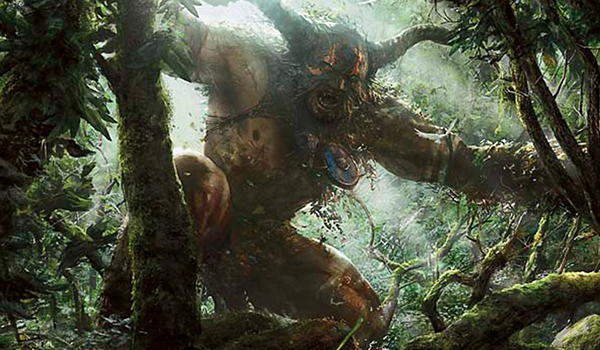
Methodology
Given the lag in large event data, I have to use less-reliable sources. I play a lot of Modern, both online and in paper, and have made plenty of observations about what is going on in both. However, I am just one data source, and can only observe a small slice of metagame activity. My experiences provide color, context, and commentary, but should not be regarded as hard data.
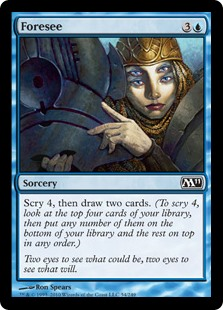 The only place where there are enough Modern events going on to develop a good data set is online. The problem with MTGO is that the data isn't entirely accurate. Wizards doesn't report the totality of League results, only curated lists. Cherry-picked data isn't valid because it reflects the choices of the surveyor, not reality. To circumvent this bias, MTGGoldfish adds in the results from Challenges and Preliminaries. MTGTop8 adds in whatever paper results get uploaded, which adds credibility and bulk to their data.
The only place where there are enough Modern events going on to develop a good data set is online. The problem with MTGO is that the data isn't entirely accurate. Wizards doesn't report the totality of League results, only curated lists. Cherry-picked data isn't valid because it reflects the choices of the surveyor, not reality. To circumvent this bias, MTGGoldfish adds in the results from Challenges and Preliminaries. MTGTop8 adds in whatever paper results get uploaded, which adds credibility and bulk to their data.
The two sites do not agree with each other in terms of metagame rankings, a result of their their differing data sets. My experience more closely reflects what Goldfish is reporting, specifically their at-time-of-writing top five decks (in order: Mono-Red Prowess, Jund, Burn, Amulet Titan, and Dredge). All these decks appear in MTGTop8's January decks to beat, but not in that order. In any case, we'll focus on those five decks today.
Burn's Back
MTGGoldfish lists Mono-Red Prowess and Burn as different decks, with Prowess being more popular. MTGTop8 makes no distinction, lumping them 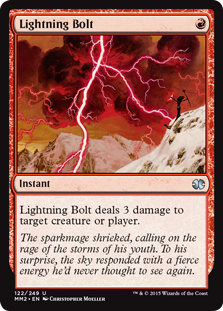 together as Red Deck Wins, but again, right now Prowess has more entries than Burn.
together as Red Deck Wins, but again, right now Prowess has more entries than Burn.
Regardless of the deck, it makes sense that a red deck would be on top right now. Burn generally does well after major metagame shakeups. This is primarily because in a time of uncertainty, people gravitate towards what they know: when they're not sure what to play because they don't know what's best anymore, they'll just play Burn. Which is never a bad decision because Burn is a good deck, and it will take major changes in how Magic works for it not to always be.
Fiery Twins
However, Burn isn't the most popular red deck at the moment; Prowess is. That's not to say that Prowess necessarily threatens Burn in the long-term.
Prowess is currently benefitting from Oko-era holdovers. Burn can deal with some amount of incidental lifegain. However, a constant stream of food is lethal. Sacrificing a food is 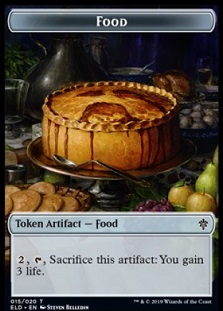 functionally the same as countering a Lava Spike, and Oko, Thief of Crowns prevented Burn from progressing its gameplan. Meanwhile, Prowess kills with big chunky turns of damage, a strategy that pushes through streams of food. Coupled with Light Up the Stage and Bedlam Reveler, Prowess had the gas it needed to stomach the feast, and was more successful.
functionally the same as countering a Lava Spike, and Oko, Thief of Crowns prevented Burn from progressing its gameplan. Meanwhile, Prowess kills with big chunky turns of damage, a strategy that pushes through streams of food. Coupled with Light Up the Stage and Bedlam Reveler, Prowess had the gas it needed to stomach the feast, and was more successful.
With that being said, Burn is historically favored in an open meta. Every spell is live for Burn late-game, whereas Lava Dart is pretty pathetic unless it's powering up several prowess creatures. Prowess is also weaker against combo decks since it can't maindeck Eidolon of the Great Revel.
More generally, Prowess relies more on creatures than Burn, and that makes it easier to answer. Jund is well-built for killing a number of one mana creatures and then racing with big Tarmogoyfs. It's much harder to race 3-4 to the face every turn after clearing a board. Which red deck emerges supreme will depend heavily on how everything else shakes out.
Place in the Sun
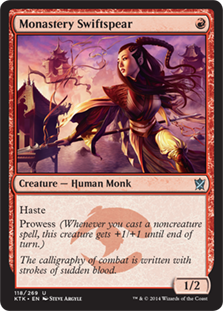 I expect both decks to fall off as the metagame develops regardless of their positioning, as typically happens. As the metagame becomes more defined and tuned, there are fewer inefficiencies and clunky decks for the streamlined red decks to exploit. Other pilots also remember that Burn exists and go back to running sideboard hate.
I expect both decks to fall off as the metagame develops regardless of their positioning, as typically happens. As the metagame becomes more defined and tuned, there are fewer inefficiencies and clunky decks for the streamlined red decks to exploit. Other pilots also remember that Burn exists and go back to running sideboard hate.
While I wouldn't expect a red deck to stay on top for that long, they will secure a long-term place in the metagame. Being the fastest aggro deck is never a bad strategy, and so long as Modern's manabase is based on fetch and shocklands, there will be room for Burn. I don't understand why players never respect Burn only to end up eating their words, but it happens constantly. Red Deck Wins will remain a high-tier deck in the immediate future, and one that must at least be accounted for in the foreseeable future.
They're Back... Again
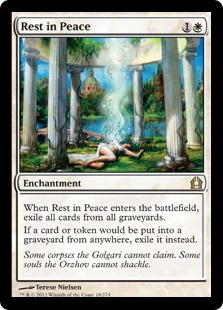 Dredge is sitting on the low end of both sites' lists, which I find very surprising. I've barely seen the deck in months, and the only times it did well was against unprepared opponents. After Faithless Looting was axed, it looked like Dredge was dead. There were some attempts to keep the deck relevant afterwards, but Dredge looked dead for good during the Oko era.
Dredge is sitting on the low end of both sites' lists, which I find very surprising. I've barely seen the deck in months, and the only times it did well was against unprepared opponents. After Faithless Looting was axed, it looked like Dredge was dead. There were some attempts to keep the deck relevant afterwards, but Dredge looked dead for good during the Oko era.
However, that's always an illusion. There's a reason my sideboarding rules include "Don't Just Lose to Dredge." As soon as players start cutting the hate, the deck comes back, as it is now.
Ox-ing Around
Every Dredge player I've asked has been raving about Ox of Agonas. However, I'm unconvinced, as every conversation has gone roughly as follows:
Me: Why is Dredge suddenly good now?
Them: Ox is insane! When I get it out turn 2 via Merchant of the Vale // Haggle turn 1 it just wrecks my opponent.
Me: How?
Them: I have a 5/3 at minimum, and I can dredge three times on turn two!
Me: Couldn't you have done that with Cathartic Reunion?
Them: Yeah, but this way I get a threat guaranteed. No spinning the roulette wheel.
Me: Only if you have an Ox to escape. And your whole deck is a roulette wheel anyway. Also, why are you Haggling the Ox? Why not just do that with a dredger?
Them: If I don't there's no guarantee I'll hit an Ox to escape.
Me: Yeah, but then you got started dredging, and possibly got to dredge on your opponent's end step, your draw step, and then three times with Cathartic.
Them: *Awkward silence/muddled spluttering*
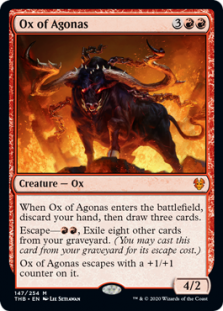 I'll admit that I could be missing something, but every line I've seen involving early Ox has been worse than just getting the dredge engine online. Every Ox turn in the mid-game has ended up in the same place as if it had been Cathartic instead. Ox hasn't shown me anything that makes Dredge actually better: it still loses to the same cards, wins the same way, and generally plays identically to how it always has, if slower now that Looting is gone.
I'll admit that I could be missing something, but every line I've seen involving early Ox has been worse than just getting the dredge engine online. Every Ox turn in the mid-game has ended up in the same place as if it had been Cathartic instead. Ox hasn't shown me anything that makes Dredge actually better: it still loses to the same cards, wins the same way, and generally plays identically to how it always has, if slower now that Looting is gone.
As I see it, Ox hasn't really made dredge any better or worse than before. Instead, it's incentivized players to pick Dredge back up, which does technically mean that it is a major factor in Dredge's return. Technically.
Going Tall
The other big deck is the biggest one: it has a Giant. Amulet Titan has become the big mana deck according to MTGGoldfish. Tron and Valakut retain places in MTGTop8's rankings thanks to strong showings in paper, but Titan is gaining on them.
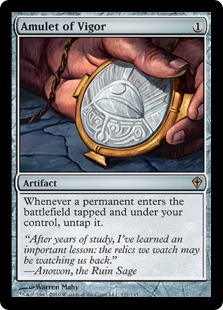 During the Oko era, Amulet was consistently putting up strong showings in Day 2 results, but those never translated into high Top 32 placements. At the time, I thought that Amulet was simply overhyped and the StarCity circuit was chasing its own hype and tail.
During the Oko era, Amulet was consistently putting up strong showings in Day 2 results, but those never translated into high Top 32 placements. At the time, I thought that Amulet was simply overhyped and the StarCity circuit was chasing its own hype and tail.
When I saw twitter threads and reddit discussions claiming that Titan was the Next Big Thing, I was dismissive. But I've since been impressed by the deck's showings, and believe that its recent meandering may have been the result of a transitional phase in deckbuilding.
Untapping a New Form
Since its coming out party, Amulet Titan has remained relatively unchanged. It's a land combo deck based on using the unique abilities of Simic Growth Chamber and its ilk, along with extra land drops and Amulet of Vigor, to generate absurd amounts of mana, drop Primeval Titan, then kill with Slayer's Stronghold and Sunhome, Fortress of the Legion. While the deck composition has shifted with the metagame over the years, the overall gameplan hasn't.
Amulet Titan, Andyscwilson (MTGO MOCS 5/13/19, 1st Place)
Everything began to change with Throne of Eldraine. Specifically, the change started with Castle Garenburg. Castle generates the mana to play Titan a turn earlier than previously possible for non-ramp decks. There's no real cost to running it, since it's not legendary and taps for green. Amulet players began favoring Castle over karoo lands.
Amulet Titan, Ouranos139 (MTGO PTQ 12/10/19, 1st Place)
Oko, Thief of Crowns facilitated this change. 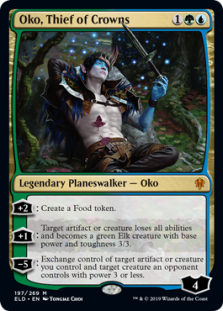 Not only was a manabase reworking necessary to accommodate Oko, the walker's existence also made the Amulet itself less valuable, as opponents could turn it into an Elk. Besides, pilots now had a functional gameplan in their own Oko.
Not only was a manabase reworking necessary to accommodate Oko, the walker's existence also made the Amulet itself less valuable, as opponents could turn it into an Elk. Besides, pilots now had a functional gameplan in their own Oko.
As Amulet of Vigor became less central, the need for Ancient Stirrings was lessened. Instead, the sometimes-free Once Upon a Time was adopted, allowing for more utility lands. But since Theros: Beyond Death, Amulet has undergone yet another growth spurt.
Amulet Titan, egadd2894 (MTGO Preliminary 1/25/20, 2nd Place)
Dryad of the Ilysian Grove means never having to worry about mana balancing and no reason not to play Valakut, the Molten Pinnacle. More creatures means more Garenburgs and no need for Stirrings. Amulet Titan is morphing from a land combo deck into a land value engine.
I've even seen decks cutting Amulet of Vigor entirely, which I don't quite know what to make of. Without Amulet pumping out Titans early, the deck strikes me as a worse Valakut.
Meanwhile, in Jund Land...
As if out of spite, Jund remains constant in the face of all that innovation. There's little need for players to substantially change the deck's gameplan or the overall configuration, though I've seen a few players with slightly tweaked threat packages, primarily featuring Hexdrinkers.
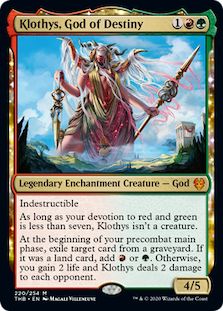 Some are also trying Klothys, God of Destiny as a mirror breaker and anti-control card, as I predicted they might. However, the feedback I've received indicates that Klothys is only relevant in really, really grindy games, making its future uncertain.
Some are also trying Klothys, God of Destiny as a mirror breaker and anti-control card, as I predicted they might. However, the feedback I've received indicates that Klothys is only relevant in really, really grindy games, making its future uncertain.
Jund's resurgence is in line with that of the red decks. With the format in disarray, players feel comfortable digging out their proven midrange deck without fear of being poorly positioned. And they no longer have to worry about the Mox-powered Simic Urza beating them at their own game. Jund is and has always been just a very solid deck, and without something obviously broken around, it's time to grind again.
The Once and Future Metagame
As the saying goes, the more things change, the more they stay the same. Jund and red decks are as Jund-and-red-decks as ever, while Amulet becomes more unrecognizable by the day. Which metagame developments have you intrigued?



